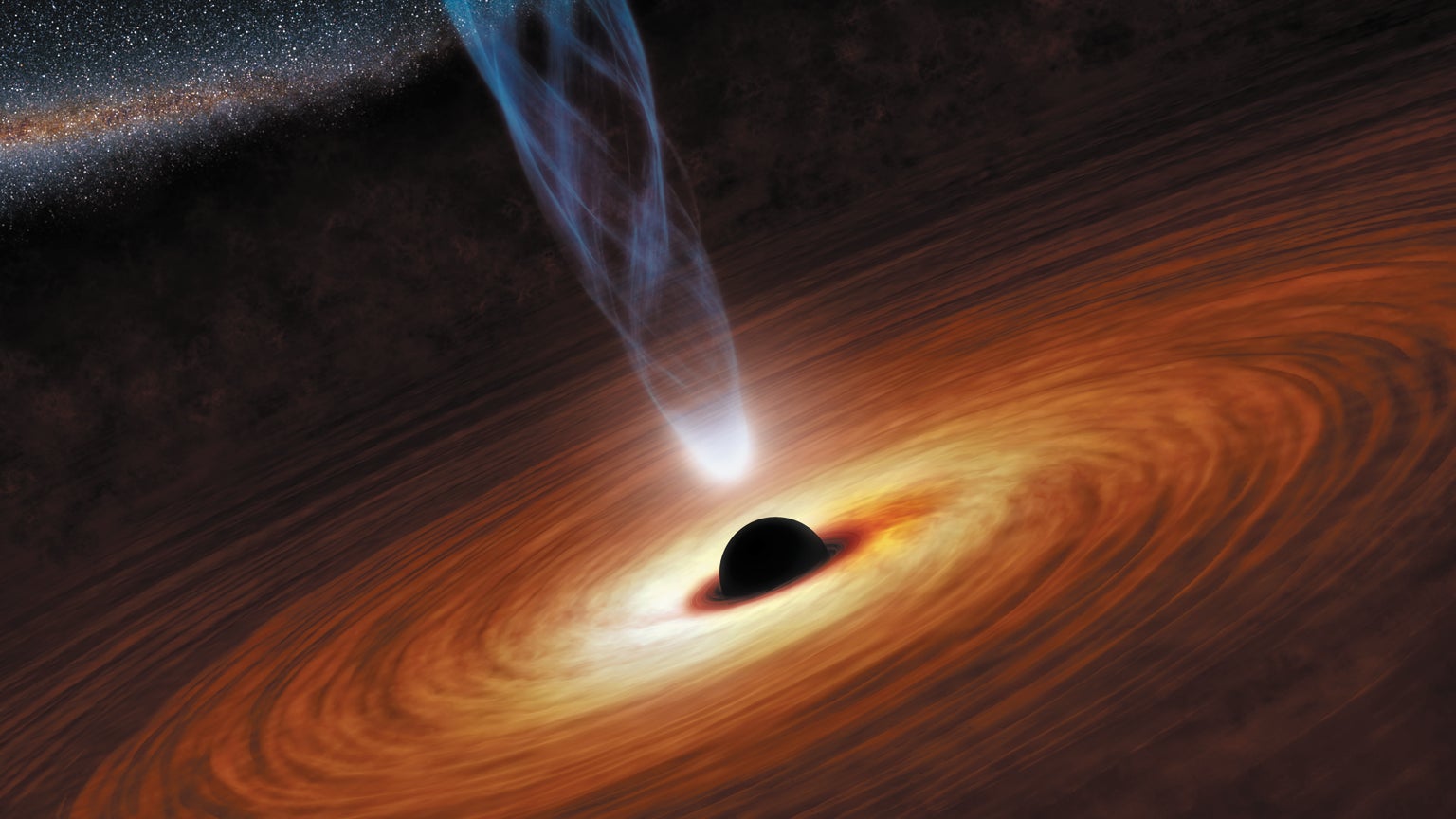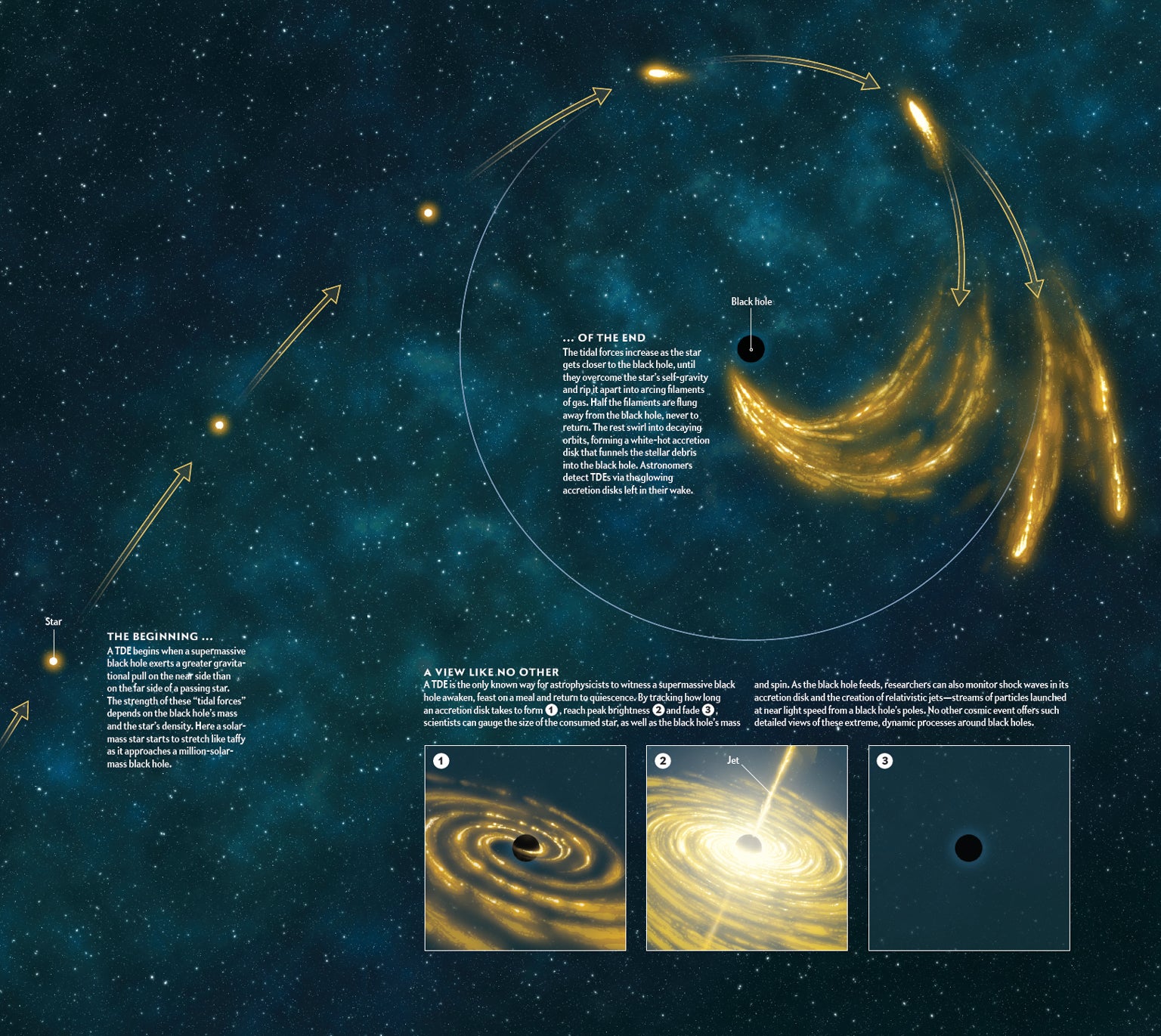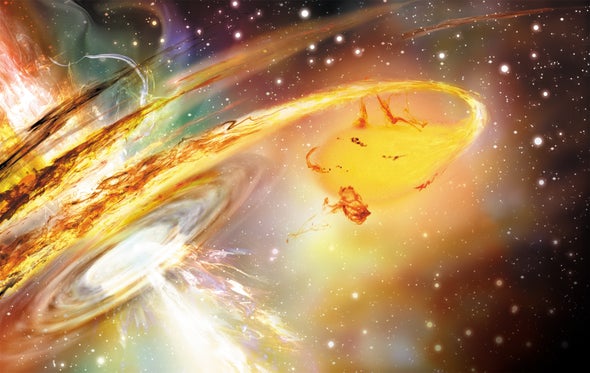At the heart of our Milky Way and of virtually every other large galaxy lurks a deep cosmic mystery—a supermassive black hole. Squeezing millions to billions of times more mass than our sun into regions smaller in size than our solar system, these objects are so bizarre as to seem almost mystical. No one yet understands exactly how nature has managed to compress so much matter into such small spaces. What is clear is that the hidden gravitational hands of supermassive black holes reach out to shape their surrounding galaxies in profound yet subtle ways. By studying the growth and behavior of these ghostly black holes, scientists hope to unlock the secrets of how galaxies themselves are born and evolve.
The trouble is that because they emit no light, supermassive black holes spend most of their time dormant and invisible to us. They come to life only when they feed, but their meals are surprisingly rare—most of the gas, dust and stars swirling around them resides in stable orbits and will never be consumed. Yet they are always hungry, and whenever something sizable does happen to fall in, the resulting feeding frenzies can be seen from far, far away.
For most of the past half a century, scientists have primarily observed just one variety of feasting black holes: quasars. Discovered by astronomer Maarten Schmidt in 1963, quasars are the ultraluminous centers of active galaxies that can be seen all the way to the outskirts of the visible universe, each shining brighter than billions of suns. They are thought to occur when massive clouds of gas and dust plunge onto a supermassive black hole for hundreds of thousands or millions of years, compressing, heating and glowing as they circle the black hole’s maw. Quasars, however, are less than ideal objects of study. They are extreme events that are typically quite distant and relatively rare, and they constitute a small portion of any supermassive black hole’s lifetime. They thus provide a limited view, leaving astronomers blind to how supermassive black holes more routinely feed and grow in the local universe. Researchers have also studied supermassive black holes by clocking the speeds of stars whizzing around them, but these measures work solely for objects very close to home—in the Milky Way or one of our immediate galactic neighbors—where current telescopes can resolve individual stars. Andrea Ghez and Reinhard Genzel shared part of the 2020 Nobel Prize in Physics for their work on the black hole at the center of our galaxy.
In 1988 astronomer Martin Rees proposed a third way to study supermassive black holes—a method that has recently begun to bear fruit. Instead of watching for the steady glow of quasars or the speeds of orbiting stars, astronomers can look for brief, bright flares of light from a black hole’s vicinity. Called tidal disruption events (TDEs), these outbursts occur when a supermassive black hole consumes an unlucky star. Unfolding over months rather than millennia, they allow researchers to track the feeding process from beginning to end and are bright enough to be observed in galaxies both near and far.

How to Destroy a Star
A tidal disruption event is far more dramatic than the gentle tides that can wash your beach towels away at the seashore, but it is not all that different in principle. Earth’s tides are chiefly caused by the gravitational tug of the moon, which pulls more strongly on the side of Earth closest to it. This difference between the moon’s gravitational pull on the far and near sides of Earth is called a tidal force. That tidal force raises a bulge, or high tide, both on the moon-facing side of Earth and, somewhat paradoxically, on the opposite face as well, which also creates a corresponding low tide, oriented 90 degrees from the Earth-moon axis. When a star is in the vicinity of a supermassive black hole—perhaps pushed there by the gravitational nudging of another nearby star—the intense tidal forces can rip it to shreds.
The details of the star’s demise depend on the sizes of both the infalling star and the supermassive black hole. A small, dense object, such as a white dwarf star, will be far more resilient against tidal forces than a larger, puffier, sunlike star—similar to how a bowling ball would be harder to rip apart than a mass of cotton candy. The very largest supermassive black holes, those containing billions of solar masses, are too big to easily create TDEs—they swallow stars whole before the tidal force becomes large enough to tear the stars apart. The tidal forces around a black hole with millions of solar masses, in contrast, will tear apart most stars that approach within about 50 million kilometers—roughly the distance of Mercury from the sun.
As spectacular as the wholesale disassembly of a star may seem, this is just the beginning of the fireworks display. After the initial disruption, the stellar debris will spread out and gradually diverge from the star’s original orbital path. Basic orbital mechanics dictates that roughly half of the debris will be expelled as long filaments of material streaming from the vicinity of the black hole, whereas the other half will loop back around to form an accretion disk—a structure of spiraling rings slowly funneling into the black hole. When the disk’s material falls in, it accelerates to nearly the speed of light and glows as gravitational and frictional forces compress and heat it to temperatures approaching 250,000 degrees Celsius. Over a span of weeks or months a typical TDE will cause a previously dormant and invisible black hole to briefly outshine all the stars in its galaxy.
The First Discoveries
Although theorists first predicted TDEs decades ago, astronomers did not detect any until the 1990s and early 2000s. This delay was in part caused by the rarity of TDEs—they occur once every 100,000 years in a galaxy like the Milky Way, according to estimates. They can also be hard to see. Simple theoretical models suggested that the glow of a TDE’s accretion disk should peak in the so-called soft x-ray or far ultraviolet parts of the electromagnetic spectrum—wavelengths that are difficult to access from the ground because of interference from interstellar dust and Earth’s atmosphere. Those same models also suggested that astronomers could use a TDE to make relatively precise estimates for the mass of its accompanying black hole—a critical data point for learning exactly how a black hole’s size alters its behavior and effects on its galactic surroundings. To measure a black hole’s mass, astronomers can simply time how long an accompanying TDE takes to reach peak brightness (which reveals how fast an accretion disk forms and feeds the black hole). Because TDEs are so bright, they allow researchers to pinpoint masses for a wider range of supermassive black holes than any other known phenomenon.
The first TDE candidates were found in data from the ROSAT x-ray and Galaxy Evolution Explorer ultraviolet space telescopes. They appeared as weeks- to months-long flaring events sourced to the centers of previously dormant galaxies. As the first manifestations of this long-predicted phenomenon, these discoveries were especially important for establishing an entirely new field of study. Because they were predominantly found in old data, however, astronomers were unable to study them across multiple wavelengths in real time to unlock their deepest secrets. To catch TDEs as they happened, astronomers would have to be either very lucky or able to continually survey mammoth swaths of sky.
As luck would have it, in the past decade steady progress in data storage and sensors has made such ambitious surveys possible. A high-end optical camera can now image one square degree or more of sky in a single snapshot, a situation akin to suddenly seeing the heavens with a panoramic lens after years of studying them by looking through a straw. By repeatedly surveying large areas of the sky and digitally combining the resulting images to tease out faint, temporary features, astronomers are now able to more easily discover and study TDEs and a host of other transient astrophysical phenomena. These new wide-field surveys, with names such as the Panoramic Survey Telescope and Rapid Response System (Pan-STARRS), the Zwicky Transient Facility (ZTF) and the All-Sky Automated Survey for Supernovae (ASAS-SN), were designed largely to identify supernovae and asteroids, but they can do much more. Because they can image millions of galaxies every night, they are also sensitive to more exotic transients such as TDEs.

New Questions for a New Era
In 2010, shortly after Pan-STARRS’s on-sky debut, a team led by astronomer Suvi Gezari discovered a TDE called PS1-10jh, which took place around a black hole of perhaps two million solar masses in a galaxy some 2.7 billion light-years from Earth. Because this TDE was noticed soon after the data were collected, Gezari and her colleagues were, for the first time, able to watch it unfold in subsequent optical and ultraviolet observations. What they found was shocking.
Based on careful measurements of its spectrum, this particular TDE appeared to be much too cold. At about 30,000 degrees C, it was more than eight times cooler than predicted by most basic theories of accretion disks. Moreover, rather than fading over weeks as its accretion disk cooled and dissipated, PS1-10jh maintained a constant temperature for many months after the initial discovery. Strangest of all, Pan-STARRS had detected signs of ionized helium in the afterglow—something that could be produced only by temperatures in excess of 100,000 degrees C. And although the TDE appeared to be helium-rich, it also seemed to be devoid of hydrogen, the most abundant element in the universe and the main ingredient of stars. Theorists got to work examining what could produce such confounding results.
To explain PS1-10jh’s lack of hydrogen, the Pan-STARRS team suggested that the disrupted star had lost its thick envelope of hydrogen at some point in the past, possibly in a previous interaction with the black hole, leaving only the star’s helium-rich core to feed the observed accretion disk. But this alone could not account for the TDE’s curious thermal discrepancies—its surprisingly low temperature and, in contradiction, its abundance of helium ionized by much higher temperatures. To solve that mystery, other theorists have postulated that PS1-10jh’s black hole–hugging accretion disk was not actually being directly observed. Instead astronomers must have seen a surrounding veil of gas much farther out from the black hole that absorbed the intense radiation produced by the accretion disk and reemitted it at lower temperatures. This veil would have the added bonus of clarifying the apparent absence of hydrogen without the need for an exotic, helium-rich core as the TDE’s progenitor. Given the right temperature and a rather high density, such a veil could potentially mask the presence of hydrogen, hiding it in plain sight.
The only trouble was that a thick veil of gas would not be stable at the required distance from the galaxy’s central black hole—over time the gas would either fall into the black hole or dissipate to invisibility. The murky origins of this material are still the subject of intense debate and study but, broadly speaking, fall into two possibilities, both related to the dynamics of a feeding black hole. As the remains of a disrupted star loop around a black hole to form a growing accretion disk, shock waves can ripple outward well away from the disk to forestall some of the outlying debris from immediately falling in, creating a temporary screen of material. Alternatively a newborn TDE accretion disk might initially funnel so much material inward that it briefly exceeds a black hole’s capacity to feed, forming transient winds or outflows just outside the black hole that push stellar debris out past the accretion disk to much larger distances.
As astronomers sorted through these muddled possibilities for PS1-10jh and other newfound TDEs that soon followed, one thing became perfectly clear: TDEs were a much more complicated phenomenon than anyone had previously appreciated. Yet the biggest surprise was still to come.
A Shock from Swift
In the predawn hours of March 28, 2011, an automated alert buzzed on the pagers and cell phones of a dedicated team of astronomers around the world. The Swift satellite had just detected a pulse of high-energy radiation from the depths of space. Built by nasa in partnership with research institutions in Italy and the U.K., Swift is an agile space telescope, designed to study all types of exploding objects across the sky. But its main targets are gamma-ray bursts, or GRBs—cataclysmic stellar explosions that are the most luminous astrophysical events in the universe. Whenever a torrent of gamma rays trickles into Swift’s sensors, the telescope quickly reorients to observe the source in x-rays and optical light and phones home to trigger a complex chain of events on Earth. Within moments of an alert from Swift, astronomers scramble to commandeer the world’s largest and most powerful telescopes to look for any emberlike afterglow associated with a GRB before it fades from view forever. Since its launch in 2004, Swift has discovered about 1,400 GRBs, but this particular event, later dubbed Swift J1644+57, proved to be unlike anything the satellite had seen before.
As their name suggests, GRBs tend to be brief, typically lasting anywhere between a fraction of a second and a few minutes. When we turned our telescopes to Swift J1644+57 on that early March morning, we expected to see the standard, fading afterglow of a short-lived GRB. Instead we observed bright, erratic gamma-ray flaring that lasted for a day, followed by months of intense but fading x-ray emissions. Soon we had traced the blast to a galaxy some 3.8 billion light-years away in the constellation of Draco. One of our colleagues, Joshua S. Bloom of the University of California, Berkeley, suggested we had witnessed a TDE and correctly predicted that this particular gamma-ray source would be found at the galaxy’s center—the stomping ground of supermassive black holes. But whereas all previous TDEs had been detected at longer, lower-energy wavelengths where observers saw the thermal emission from the accretion disk of a shredded star, this was something wholly different.
How could a TDE produce gamma rays? The best answer we could come up with is that black holes are messy eaters. A black hole would devour most of a disrupted star’s gas, locking it away forever behind an event horizon (the boundary past which the black hole’s gravitational pull is so great that not even light can escape). But all black holes probably spin, and this spin can push a few percent of the disrupted star’s total gas toward the black hole’s poles, outside the event horizon, where the gas is accelerated and ejected as collimated beams of particles moving at nearly the speed of light. The fast-moving beams emit gamma rays and x-rays as they hurtle through the cosmos. Apparently Swift had happened to find itself in the path of Swift J1644+57’s beam. It was a lucky catch—not all TDEs appear to power such relativistic outflows, and most of those that do likely miss our line of sight.
With the detection of Swift J1644+57 as inspiration, the Swift team began a concerted search for more events. As of early 2021, three more TDEs emitting gamma-ray jets have been found. These rarest and most intense death cries of stars are a novel way to study one of the foremost research topics in modern high-energy astrophysics—the creation and behavior of relativistic particle jets.
The Death of Worlds
Whether through the thermal emissions from accretion disks of stellar debris or the gamma rays pouring off a star-devouring black hole’s relativistic jets, TDEs offer a new window on the behavior and evolution of supermassive black holes and their surroundings. Most important, unlike the far larger and longer-duration jets and accretion disks of quasars, which are produced by immense clouds of gas chaotically plummeting onto a supermassive black hole across very long timescales, TDEs are brief, clean events that are more easily studied. No human being will ever live long enough to witness the complete life cycle of a single quasar, but already astronomers have found and studied more than 30 TDEs from beginning to end. And in the details of those stellar catastrophes, they have glimpsed tantalizing quirks begging for further study. By precisely measuring the fluctuating flares from TDEs, astronomers are learning not only about black holes but also about the detailed compositions and internal structures of stars being ripped apart billions of light-years away.
They may even eventually learn about a star’s companions, too—planets swallowed by black holes. Each flickering flash from a faraway galactic center could signal the deaths of entire worlds. Surveys of stars in our own galaxy have found that almost every one harbors planets; planets probably accompany most, if not all, of the stars in other galaxies as well, including those that suffer TDEs. Even if they were not directly consumed, planets could still find themselves in the path of the transient relativistic jets produced by some TDEs, which extend light-years beyond their black hole sources. Life in any planetary systems unlucky enough to be struck by such a beam would be rapidly extinguished. Someday astronomers may witness a TDE right in our cosmic backyard, when the four-million-solar-mass black hole quiescently lurking at the gas-impoverished center of our very own Milky Way flares to life as it consumes some errant star. It would be very bright but also very safe because we are too far from the galactic center for the TDE’s most dangerous effects to reach us here.
The advent of even more powerful surveys heralds a new era of TDE discoveries. The Vera C. Rubin Observatory, an eight-meter telescope currently being constructed in Chile with a field of view covering 10 square degrees of sky, will by itself uncover thousands of these outbursts within a decade of its debut. In some ways, the most challenging aspect of Rubin science will be sifting through the overwhelming number of transient discoveries. Planned radio observatories such as the Square Kilometer Array being built in Australia and South Africa are particularly well suited to identify relativistic jets, even if such jets are “off axis,” meaning they are not beamed directly along our line of sight.
In the not too distant future, astronomers may have assembled a TDE catalog with thousands on thousands of entries, more than any individual could study in a lifetime, shedding new light on the masses and behaviors of those elusive hungry ghosts, the otherwise inaccessible supermassive black holes that reside in the hearts of galaxies all across the universe. From that rich, ever growing corpus of knowledge, we can only dream of what further revolutionary discoveries may come.




